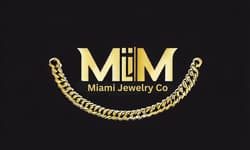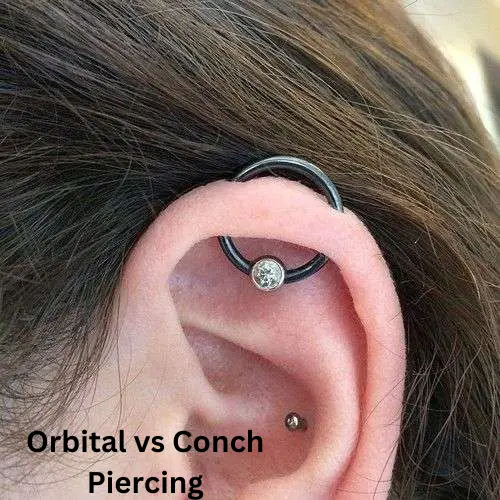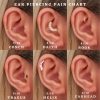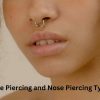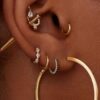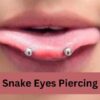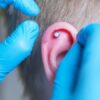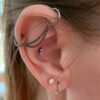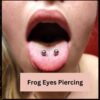Ear Piercing
Orbital vs Conch Piercing: Which One’s for You? A Complete Comparison Guide
Choosing between the Orbital and Conch piercings is a challenge, given the distinct charm of each.
In a hurry? Here’s a quick answer: Orbital and Conch piercings both offer unique aesthetic appeals but differ significantly in placement and style. An Orbital piercing consists of two holes that are connected by a single piece of jewelry, offering versatility as it can be positioned in multiple locations around the ear. In contrast, a Conch piercing specifically targets the inner or outer cartilage of the ear, punctured with a single hole, usually adorned with a stud or hoop. Both bring their own charm and intricacies, making the choice largely dependent on your personal preference and pain tolerance.
Your piercing choice is not just a fashion decision. It encompasses pain tolerance, aftercare commitment, and the vibe you wish to convey. Our guide zeroes in on these piercings, presenting insights into pain levels, healing processes, style nuances, and expert recommendations.
Here’s a snapshot of what’s coming up:
- A deep dive into the world of Orbital Piercing and Conch Piercing.
- Comparing the pain – yes, the part most of us dread.
- Healing processes, aftercare, and what to expect.
- The fashion quotient of each – who’s leading the trend charts?
- Cost dynamics – Is one heavier on the wallet?
- In-depth contrasts between the two.
- The expert takes and their golden recommendations.
- Plus, a comprehensive FAQ to quell any remaining queries.
So, if you’ve been sitting on the fence, unsure which piercing path to tread, let this guide be your decisive beacon. Dive in!
Contents
- 1 What is Orbital Piercing?
- 2 What is Conch Piercing?
- 3 Pain Level: Which One Hurts More?
- 4 Orbital vs Conch Piercing – Healing Process and Aftercare
- 5 Orbital and Conch Piercing Pros and Cons
- 6 Orbital vs. Conch Piercing – The Fashion Statement: – Which is More Trendy?
- 7 Video Guide to Explain Orbital vs. Conch Piercing
- 8 Orbital vs. Conch Piercing – Cost Comparison
- 9 Orbital piercing vs. Conch Detailed Comparison Table
- 10 Expert Opinions and Recommendations
- 11 FAQs
- 12 Final Words – Orbital vs Conch Piercing
What is Orbital Piercing?
An Orbital piercing, in essence, is a combination of two piercings connected with a single piece of jewelry, typically a ring. Imagine a ship sailing smoothly through two close ports – that’s your Orbital piercing. Located most commonly in the helix or lobe of the ear, the two piercings run parallel, allowing the ring to pass through both, giving the illusion of it orbiting through the ear. The placement and appearance can be akin to Saturn and its illustrious rings. Pretty neat, right?
- Related: Rook Piercing vs Daith
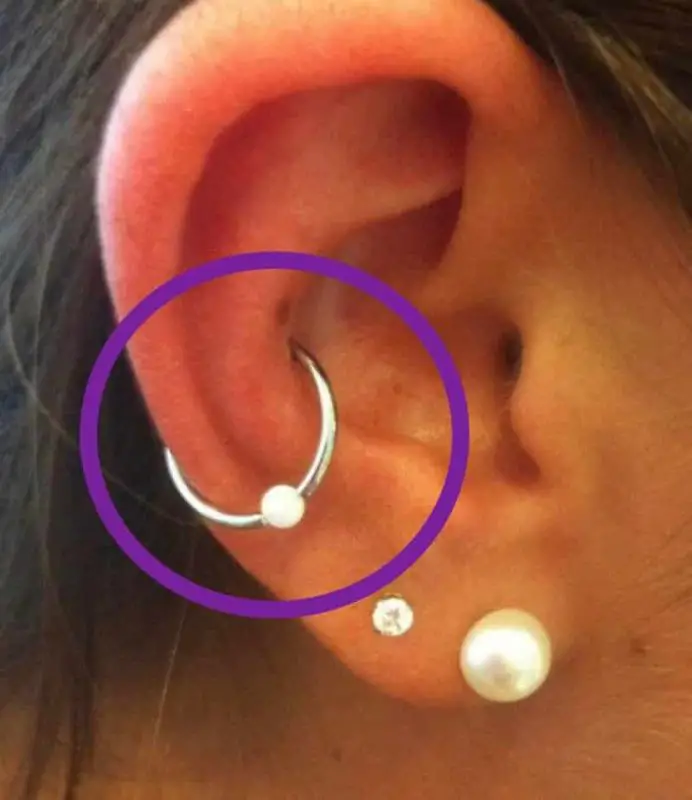
Popular Jewelry Choices for Orbital Piercing
Stepping into a jewelry shop or browsing online, you’ll be spoilt for choice when it comes to Orbital piercings. However, a few standouts have captured the hearts of many:
- Seamless Rings: These give a clean, unbroken look, enhancing the orbital effect.
- Beaded Rings: A small bead adds flair, serving as a focal point on the ring.
- Twisted Rings: If you’re looking for a boho touch, these spiral-inspired rings are perfect.
- Segment Rings: These have a piece (or segment) that can be removed, making them easy to fit.
- Hinged Rings: These rings have a hinge mechanism, allowing easy opening and closing.
Whether you’re going for an understated look or a statement piece, there’s an Orbital jewelry piece waiting for you.
What is Conch Piercing?
A Conch piercing, named after the conch shell because of the resemblance in its placement, is a type of ear piercing that is placed in the curved cartilage of the inner ear. It can be further divided into two types: inner and outer Conch piercings, depending on the exact location of the piercing.
It has emerged as a favorite for many and is an undeniably unique and attractive addition to one’s piercing collection.
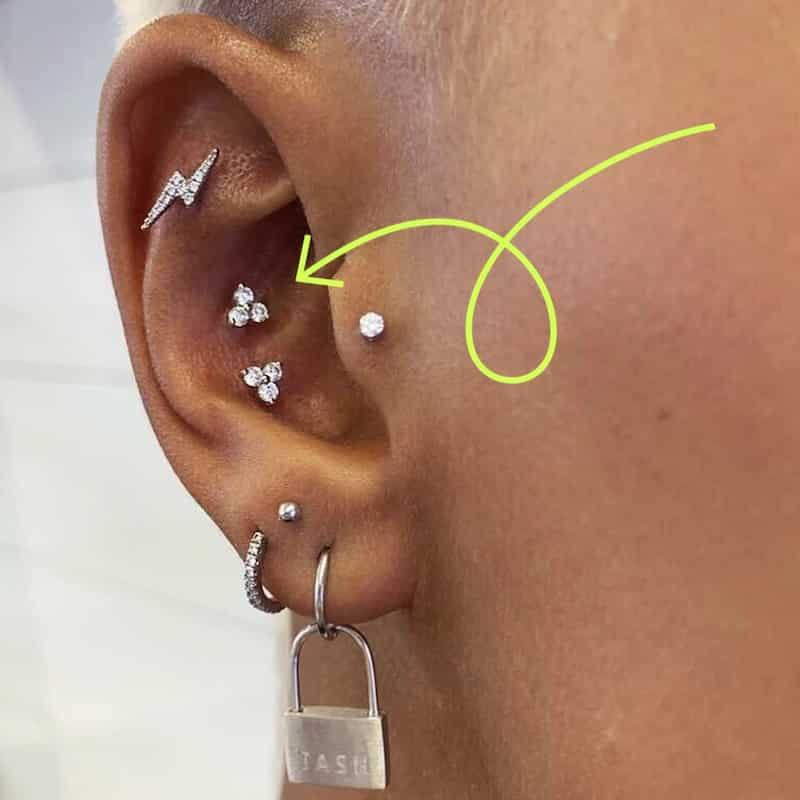
Inner vs. Outer Conch Piercing
The ear, while seemingly simple, offers a complex canvas for piercings. The Conch piercing takes advantage of this intricate anatomy. There are two main types:
Inner Conch Piercing:
This is situated in the middle portion of your ear cartilage, directly adjacent to the ear canal. If you ever whispered secrets into a conch shell, the Inner Conch would be where the shell’s mysterious cavern starts.
Outer Conch Piercing:
Located on the flat part of the external ear cartilage, it’s closer to the outer rim. Imagine the wide, open span of a conch shell – that’s where the Outer Conch piercing resides.
Both offer distinct looks and are equally enchanting. The choice boils down to personal preference and anatomy.
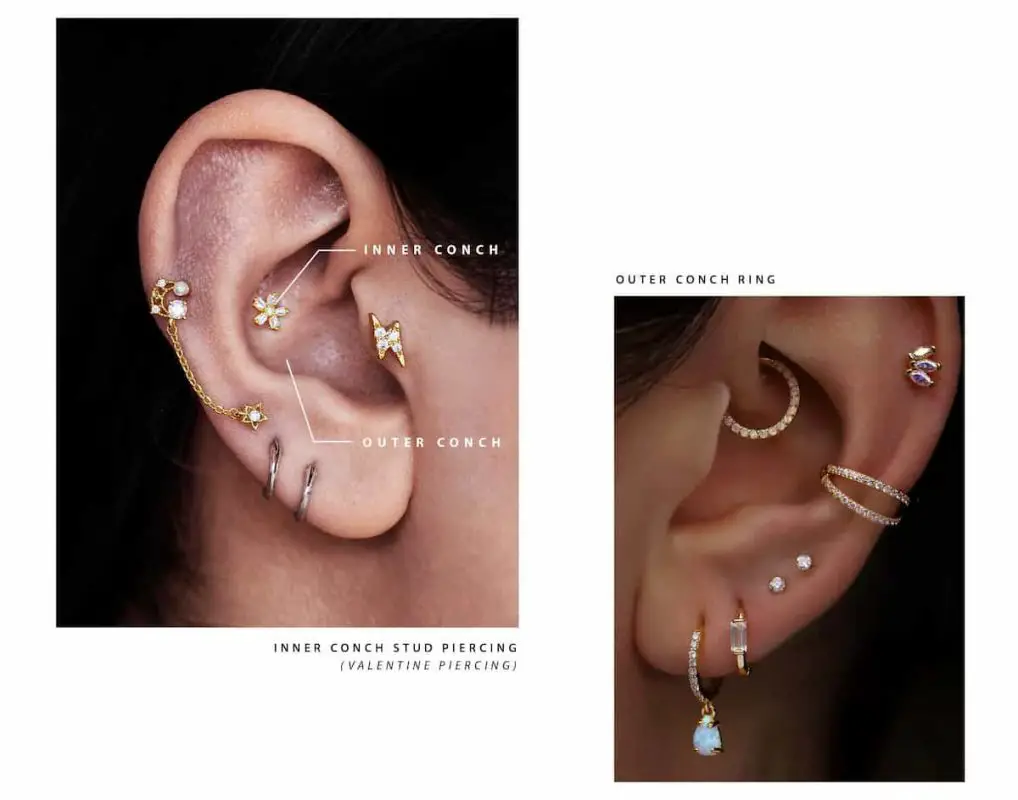
Conch Piercing Explanation In Video Guide
Popular Jewelry Choices for Conch Piercing
When it comes to adorning your Conch piercing, the sky’s the limit. Here are some popular picks:
- Studs: A classic choice, especially for the inner conch. They’re subtle yet striking.
- Labret Studs: With a flat back, these are comfortable and particularly suited for fresh piercings.
- Hoop Rings: For those leaning towards a more bohemian flair, hoops in the outer conch are stunning.
- Barbells: These can be both simple and decorative, adding a touch of edge to your look.
Orbital Piercing: A Glimpse to its Roots
The Orbital piercing, while seemingly modern, has echoes in various cultures. Ancient tribes often used piercings, including those similar to the Orbital style, as rites of passage or as symbols of status. Over time, as cultures intermingled and the world grew more interconnected, the Orbital piercing evolved, merging ancient significance with modern aesthetics.
Conch Piercing: Ancient Cultures and Modern Adaptations
Conch piercings have an even more storied past. Tribal communities, especially in regions of Africa and the Americas, have flaunted conch-like piercings for centuries. These piercings weren’t just about beauty; they often signified spiritual connections, warrior status, or coming-of-age ceremonies. Today, while many opt for a Conch piercing for its beauty, the depth of its history adds an extra layer of allure.
Pain Level: Which One Hurts More?
Ah, the question on everyone’s mind! When it comes to piercings, pain is often a determining factor for many. But remember, pain is subjective and varies from person to person.
Orbital Piercing Pain Assessment
Given that the Orbital piercing involves two separate perforations, you might assume it’s doubly painful. In reality, many describe the sensation as a sharp pinch, followed by a burning or throbbing sensation. The helix region, where the Orbital piercing is commonly placed, has relatively fewer nerve endings compared to other parts of the ear, making the process more bearable for most.
Conch Piercing Pain Expectations
The Conch, being a chunkier part of the cartilage, can be a bit more intimidating. Most individuals rate the pain level as moderate. The initial puncture is often described as intense, but it’s quick. Aftercare and healing can be a bit more challenging given the location, but with proper care, it’s manageable.
In the end, while there’s no escaping the pain, the brief discomfort yields a lifetime of aesthetic pleasure. As the saying goes, “Beauty is pain.” Or in this case, just a pinch!
Orbital vs Conch Piercing – Healing Process and Aftercare
You’ve got your piercings, and you’re excited! But just like getting a tattoo or any other body modification, aftercare is paramount. The journey from a fresh piercing to a fully healed one can be smooth with the right steps.
Orbital Piercing: Steps for Swift Healing
- Clean Regularly: Use a saline solution to gently cleanse the pierced area twice daily.
- Avoid Fiddling: As tempting as it might be, refrain from touching or rotating the jewelry.
- Pillow Talk: Consider using a clean, soft pillowcase and try sleeping on the side opposite your piercing to reduce irritation.
- Avoid Swimming: Stay away from pools or hot tubs during the initial healing phase to prevent potential infections.
- Listen to Your Body: If something feels off, consult your piercer or a medical professional.
Conch Piercing: Ensuring Proper Recovery
- Saline Soaks: Dip a clean cotton ball in saline solution and gently press against the piercing.
- No Earbuds: Refrain from using earbuds until the piercing is fully healed.
- Hair Care: Ensure your hair stays clean and is tied back, so it doesn’t get tangled with the jewelry.
- Avoid Harsh Products: Steer clear of alcohol, hydrogen peroxide, or scented lotions.
Orbital and Conch Piercing Pros and Cons
Every piercing comes with its highs and lows. Knowing them can help you make an informed choice.
Benefits of Orbital Piercing
- Versatile Look: Suitable for both minimalist and bold styles.
- Less Common: Offers a unique look as it’s less prevalent than standard lobe piercings.
- Customizable: This can be combined with other piercings for a dynamic effect.
Drawbacks to Consider
- More Than One: Since it involves two perforations, it might be slightly more painful.
- Healing Time: Might take longer to heal due to the dual piercings.
Benefits of Conch Piercing
- Statement Piece: Acts as a focal point and stands out.
- Historical Significance: Carries a rich cultural history.
- Variability: Can opt for inner or outer, each offering a distinct look.
Potential Downfalls
- Pain Level: Typically considered more painful than other piercings.
- Extended Healing: Can take longer to heal due to its cartilage location.
Orbital vs. Conch Piercing – The Fashion Statement: – Which is More Trendy?
The world of fashion is ever-evolving. While the Orbital piercing offers subtle elegance and can be paired seamlessly with other ear adornments, the Conch piercing acts as a standout piece, turning heads all on its own. Both have been sported by celebrities and influencers alike, making them both fashionable in their unique ways. The true trendiness? It’s all about how you wear it!
- Related: Pain Ear Piercing Chart
Video Guide to Explain Orbital vs. Conch Piercing
Orbital vs. Conch Piercing – Cost Comparison
When it comes to piercings, the price tag is often reflective of the expertise of the piercer and the quality of the jewelry.
Orbital Piercing Costs
Generally ranging from $40 to $90, the price might increase if you opt for high-end jewelry.
Conch Piercing Costs
Typically it sets you back between $50 to $100, depending on your location and the studio’s reputation.
Orbital piercing vs. Conch Detailed Comparison Table
| Aspect | Orbital Piercing | Conch Piercing |
|---|---|---|
| Definition and Placement | Involves two perforations in the ear, connected by one jewelry piece. | Located in the ear’s cartilage, either inner (adjacent to the ear canal) or outer (flat part of the ear). |
| Popular Jewelry Choices | Hoops, Circular Barbells | Studs, Labret Studs, Hoop Rings, Barbells |
| History and Origin | Ancient tribes used similar styles as status symbols or rites of passage. | Historically significant in tribal communities across Africa and the Americas for spiritual and status symbols. |
| Pain Level | Moderate; involves two separate perforations. | Moderate to intense, given its cartilage location. |
| Healing Process & Aftercare | Clean with saline solution, Avoid touching or rotating, Use clean, soft pillowcases, Refrain from swimming | Saline soaks, No earbuds, Keep hair away, Avoid harsh products |
| Benefits | Versatile look, Unique due to being less common, Can be combined with other piercings | Acts as a statement piece, Rich cultural history, Inner or outer options offer variability |
| Drawbacks | $40 to $90 (depending on jewelry and studio) | Considered more painful, Extended healing time due to cartilage location |
| Fashion Statement | Subtle elegance; pairs well with other piercings. | Standout piece; acts as a focal point. |
| Cost | Start with one, and ensure proper healing before another. | $50 to $100 (varies based on location and studio) |
| Expert Recommendation | Start with one, ensure proper healing before another. | Based on personal style, pain threshold, and desired healing time. |
Expert Opinions and Recommendations
Most piercing professionals suggest starting with one piercing, ensuring it heals properly, and then venturing into another. While both piercings are revered, the choice often boils down to personal style, pain threshold, and desired healing time.
FAQs
How long does an Orbital piercing take to heal completely?
Typically 3-6 months, but it varies depending on individual healing processes.
Is the Conch piercing suitable for all ear shapes?
Mostly yes, but consult with a professional for personalized advice.
Can I get both Orbital and Conch piercings at the same time?
It’s possible, but healing might be more challenging. Discuss with your piercer.
What is the ideal gauge size for each piercing?
Generally, 14G or 16G, but it can vary based on individual preferences
Which piercing is more prone to infections, and how can I prevent them?
Both have risks if aftercare isn’t followed. Regular cleaning with a saline solution is crucial.
Is the conch the most painful piercing?
The conch piercing is considered moderately painful due to its location in the cartilage. However, pain is subjective, and while some might find the conch piercing more painful, others might find different piercings, such as the daith or rook, more intense. It’s essential to note that everyone’s pain tolerance is unique.
Can I get an orbital conch?
Yes, an orbital conch piercing is a variation where two piercings are made within the conch area and are connected with a single hoop earring. It merges the styles of both the orbital and conch piercings to create a distinctive look.
What is the difference between a conch and an outer conch piercing?
A conch piercing can be categorized into two types: inner and outer. The inner conch piercing is located adjacent to the ear canal, whereas the outer conch piercing is situated in the flat part of the top outer ear. The primary difference is their specific placement within the ear’s cartilage.
What’s the difference between an orbital and a conch piercing?
An orbital piercing involves two perforations in the ear that are connected by a single piece of jewelry, typically a hoop. It can be located in various parts of the ear, including the helix or the lobe. On the other hand, a conch piercing is specifically located within the ear’s cartilage, either as an inner conch (near the ear canal) or an outer conch (flat part of the ear). The primary distinction is in their placement and the number of perforations involved.
Final Words – Orbital vs Conch Piercing
In the grand tapestry of ear piercings, both the Orbital and Conch shine bright. While they differ in placement, history, and aesthetics, both offer unique charms that can enhance one’s personal style. The decision lies in what resonates with you, your lifestyle, and your fashion sensibilities.

Camila Luna is a passionate jewelry enthusiast and content creator at Miami Jewelry Co. With a focus on providing high-quality, Miami-style jewelry, Camila and her team specialize in a wide range of jewelry that includes bracelets, necklaces, earrings, and more
